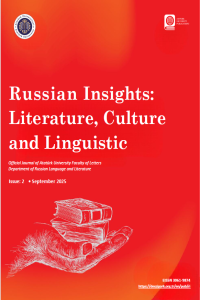Abstract
The process of mastering any language is associated with familiarity with the culture of these people. Folklore as a part of culture is well known to native speakers, is a fabric of cultural ideas and traditions, and is inextricably linked with the history of domestic animals. These creatures, formerly wild companions, were strongly settled into human communities, shaping and being influenced by our narratives. The author examines the images of domestic animals of different peoples that are found in folklore texts. Attention is drawn to the fact that each nation has its attitude toward a particular animal, which is most often reflected in proverbs and sayings. This investigation explores the metaphorical functions of common farmyard companions such as cows, dogs, and cats in folktales throughout the world. The loyal dog, a defender and companion, may transform into a frightening guardian spirit. Finally, folklore provides insight into the unique bond between humans and the tamed world, illustrating how these creatures have not only served us but also captivated our imaginations throughout millennia.
References
- Burenkova, S. V. (2008). Zoomorphic images of German and Russian phraseology. Bulletin of the Chelyabinsk State University, (30), 29–40. https://cyberleninka.ru/article/n/zoomorfnye-obrazy-nemetskoy-i-russkoy-frazeologii
- Omer, B. (2015). Images of pets in Russian phraseology (against the background of the Turkish language). Bulletin of the Bryansk State University, (3), 212–215. https://cyberleninka.ru/article/n/obrazy-domashnih-zhivotnyh-v-russkoy-frazeologii-na-fone-turetskogo-yazyka
- Omer, B. (2016). Zoomorphic images in Russian proverbs and sayings: Linguocultural and lexicographic aspects [Abstract of the dissertation of the Candidate of Philology, Smolensk State University Publishing House]. http://irbis.gnpbu.ru/Aref_2016/Бичер.pdf
- Sibgayeva, F., & Mugtasimova, G. (2023). Linguistic verbalization of related emotions in phraseological units of the Tatar language. Philology and Culture, (4), 79–86. https://filkult.elpub.ru/jour/article/view/440
Abstract
Herhangi bir dili öğrenme süreci, o dili konuşan halkın kültürüyle tanışmayı da beraberinde getirir. Kültürün bir parçası olan folklor, ana dili konuşan kişiler tarafından iyi bilinir; kültürel fikirlerin ve geleneklerin dokusunu oluşturur ve evcil hayvanların tarihiyle ayrılmaz bir biçimde bağlantılıdır. Bir zamanlar vahşi olan bu canlılar, insan topluluklarına güçlü biçimde yerleşmiş hem anlatılarımızı şekillendirmiş hem de onlardan etkilenmiştir. Yazar, farklı halkların folklor metinlerinde yer alan evcil hayvan imgelerini incelemektedir. Her milletin belirli bir hayvana karşı özel bir tutumu olduğu ve bunun çoğunlukla atasözleri ve deyimlerde yansıma bulduğu vurgulanmaktadır. Bu çalışma, dünyanın dört bir yanındaki halk masallarında inek, köpek ve kedi gibi yaygın evcil hayvanların metaforik işlevlerini araştırmaktadır. Sadık köpek, bir koruyucu ve yoldaş olmasının yanı sıra zamanla korkutucu bir ruhani varlığa da dönüşebilir. Sonuç olarak, folklor, insanlar ile evcilleştirilmiş doğa arasındaki benzersiz bağı gözler önüne serer; bu canlıların yalnızca bize hizmet etmekle kalmayıp binlerce yıldır hayal gücümüzü de büyülediğini ortaya koyar.
References
- Burenkova, S. V. (2008). Zoomorphic images of German and Russian phraseology. Bulletin of the Chelyabinsk State University, (30), 29–40. https://cyberleninka.ru/article/n/zoomorfnye-obrazy-nemetskoy-i-russkoy-frazeologii
- Omer, B. (2015). Images of pets in Russian phraseology (against the background of the Turkish language). Bulletin of the Bryansk State University, (3), 212–215. https://cyberleninka.ru/article/n/obrazy-domashnih-zhivotnyh-v-russkoy-frazeologii-na-fone-turetskogo-yazyka
- Omer, B. (2016). Zoomorphic images in Russian proverbs and sayings: Linguocultural and lexicographic aspects [Abstract of the dissertation of the Candidate of Philology, Smolensk State University Publishing House]. http://irbis.gnpbu.ru/Aref_2016/Бичер.pdf
- Sibgayeva, F., & Mugtasimova, G. (2023). Linguistic verbalization of related emotions in phraseological units of the Tatar language. Philology and Culture, (4), 79–86. https://filkult.elpub.ru/jour/article/view/440
Abstract
Процесс овладения любым языком связан с ознакомлением с культурой народа, на котором этот язык говорит. Фольклор как часть культуры хорошо известен носителям языка, представляет собой ткань культурных представлений и традиций, и неразрывно связан с историей домашних животных. Эти существа, некогда дикие спутники, прочно вошли в человеческое общество, формируя и одновременно подвергаясь влиянию наших повествований. Автор рассматривает образы домашних животных у разных народов, встречающиеся в фольклорных текстах. Отмечается, что у каждого народа существует своё отношение к тому или иному животному, что чаще всего отражается в пословицах и поговорках. В исследовании анализируются метафорические функции таких обычных домашних животных, как коровы, собаки и кошки, в фольклоре разных народов мира. Верная собака, защитник и спутник, может превращаться в устрашающего духа-хранителя. В итоге фольклор даёт представление об уникальной связи между человеком и одомашненным миром, показывая, что эти существа не только служили нам, но и на протяжении тысячелетий пленяли наше воображение.
References
- Burenkova, S. V. (2008). Zoomorphic images of German and Russian phraseology. Bulletin of the Chelyabinsk State University, (30), 29–40. https://cyberleninka.ru/article/n/zoomorfnye-obrazy-nemetskoy-i-russkoy-frazeologii
- Omer, B. (2015). Images of pets in Russian phraseology (against the background of the Turkish language). Bulletin of the Bryansk State University, (3), 212–215. https://cyberleninka.ru/article/n/obrazy-domashnih-zhivotnyh-v-russkoy-frazeologii-na-fone-turetskogo-yazyka
- Omer, B. (2016). Zoomorphic images in Russian proverbs and sayings: Linguocultural and lexicographic aspects [Abstract of the dissertation of the Candidate of Philology, Smolensk State University Publishing House]. http://irbis.gnpbu.ru/Aref_2016/Бичер.pdf
- Sibgayeva, F., & Mugtasimova, G. (2023). Linguistic verbalization of related emotions in phraseological units of the Tatar language. Philology and Culture, (4), 79–86. https://filkult.elpub.ru/jour/article/view/440
Details
| Primary Language | English |
|---|---|
| Subjects | Russian Language, Literature and Culture, Cultural Studies (Other) |
| Journal Section | Reviews |
| Authors | |
| Early Pub Date | August 21, 2025 |
| Publication Date | September 1, 2025 |
| Submission Date | July 19, 2024 |
| Acceptance Date | March 10, 2025 |
| Published in Issue | Year 2025 Issue: 2 |
Russian Insights: Literature, Culture and Linguistic is licensed under a Creative Commons Attribution NonCommercial 4.0 International License.

